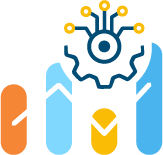As organizations strive to modernize and optimize their operations, machine learning (ML) has emerged as a valuable tool for driving automation. Unlike traditional rule-based automation, ML excels in handling complex processes and continuously learns, leading to improved accuracy and efficiency over time.
Challenges faced
Despite the potential benefits, many companies are stuck in the pilot stage, having developed a few isolated ML use cases but struggling to implement them more broadly. According to a recent survey, only 15 percent of respondents have successfully scaled automation across multiple business areas, with just 36 percent deploying ML algorithms beyond the pilot stage. This lack of progress can be attributed to existing institutional knowledge about processes being rarely fully documented, and simple rule sets do not easily capture many decisions. Furthermore, the available sources of information on scaling ML are often too high-level or too technical to be effectively actionable, leaving leaders without clear guidance on navigating the adoption of ML algorithms.
The value at stake
Incorporating ML into processes offers substantial value for organizations. Leading companies have reported increasing process efficiency by over 30 percent and a 5 to 10 percent revenue boost. For instance, a healthcare company successfully employed a predictive model to classify claims across risk categories, resulting in a 30 percent increase in claims paid automatically and a 25 percent reduction in manual effort. Furthermore, ML-enabled processes enable organizations to build scalable and resilient systems that continue to unlock value for years.
Key takeaways
- Move beyond pilot projects. Scale automation initiatives beyond isolated ML use cases and expand implementation across various business areas.
- Capture institutional knowledge. Document institutional knowledge to preserve valuable insights and facilitate effective utilization.
- Embrace complexity. Recognize that ML algorithms handle complex decisions and complex processes.
- Actionable guidance. Seek practical and accessible information on scaling ML, enabling non-technical team members to implement it effectively.
- Measure impact. Continuously evaluate the impact of ML implementation on process efficiency and revenue generation.
- Build scalable and resilient systems. Leverage ML to develop processes that can adapt and evolve, providing long-term value to the organization.
How to make an impact with Machine Learning: a four-step approach
Machine learning technology and its applications are advancing rapidly, often leaving leaders overwhelmed by the pace of change. Leading organizations are adopting a four-step approach to effectively integrate machine learning into their operational processes to simplify the process.
Step 1: Fostering economies of scale and expertise
When operationalizing machine learning (ML) in processes, organizations often make the mistake of focusing on individual steps controlled by specific teams. This fragmented approach dilutes the overall value of ML and strains resources. To overcome this, fostering collaboration across business units and embracing a holistic perspective on automation is essential.
Breaking down silos: Encourage cross-functional collaboration rather than isolated efforts. This ensures that ML initiatives are scalable beyond proof of concept and addresses critical implementation aspects like model integration and data governance.
Designing end-to-end automation: Instead of applying ML to isolated steps, design processes that can be automated from start to finish. Identify common elements across multiple steps, such as inputs, review protocols, controls, processing, and documentation, to unlock ML potential.
Capitalizing on similarities: Explore similar archetype use cases, such as document processing or anomaly detection. Organizations can leverage ML at scale and tap into synergistic opportunities by grouping these use cases.
Organizations can harness economies of scale and expertise by adopting a collaborative and holistic approach, paving the way for impactful ML implementation in processes.
Step 2: Evaluating capability requirements and development approaches
In the second step, it is essential to determine the specific capabilities that a company requires based on the archetype use cases identified in the previous step. For instance, companies aiming to enhance their controls may need to develop capabilities for anomaly detection. At the same time, those struggling with digital channel migration might prioritize language processing and text extraction.
When it comes to building the necessary machine learning (ML) models, there are three main options available:
Internal development: Companies can choose to build fully customized ML models in-house. This approach demands significant time and resources to create tailored solutions that address their unique requirements.
Platform-based solutions: Another option is to leverage platform-based solutions that offer low- and no-code development approaches. These solutions simplify the ML development process and require less coding expertise, enabling faster implementation.
Point solutions: Companies can purchase pre-built point solutions tailored for specific use cases. While this approach is easier and faster to implement, it may involve trade-offs and limitations compared to fully customized models.
It is essential to assess various interconnected factors to make an informed decision among the available options. This includes considering whether a particular data set can be utilized across multiple areas and how machine learning (ML) models align with broader process automation efforts. While implementing ML in basic transactional processes, such as those found in back-office functions in the banking industry, can yield initial automation progress, it may not lead to a sustainable competitive advantage. In such cases, leveraging platform-based solutions that capitalize on existing system capabilities is often the most suitable approach. By carefully evaluating these factors, organizations can navigate the decision-making process and choose the option that best aligns with their needs and objectives.
Step 3: Training models in real-world environments
In the process of operationalizing machine learning (ML), one of the critical aspects is providing on-the-job training to the models. This means that the models learn and improve through quality data analysis. However, several considerations and challenges need to be addressed in this step:
Data management and quality: The main challenge lies in finding quality data from which ML algorithms can effectively analyze and learn. Companies may face difficulties in data management and ensuring data quality, mainly when dealing with multiple legacy systems and when data is not rigorously cleaned and maintained across the organization.
Sequential environments: ML deployments typically involve three distinct environments: the developer environment, the test environment (also known as user-acceptance testing or UAT), and the production environment. In the developer environment, systems are built and can be easily modified. The test environment allows users to test system functionalities, but modifications to the system are restricted. Finally, the production environment is where the system is live and available at scale to end users.
Optimal training in the production environment: While ML models can be trained in any of these environments, the production environment is generally considered the most optimal. It utilizes real-world data, allowing the models to learn and adapt to operating conditions. However, certain limitations may arise, especially in highly regulated industries or industries with significant privacy concerns, where not all data can be used in all three environments.
By carefully managing data quality, leveraging the sequential environments, and considering regulatory and privacy constraints, organizations can effectively provide ‘on-the-job’ training to their ML models, enabling them to learn and improve in real-world scenarios.
In regulated industries like banking, developers often face limitations in the development environment due to regulatory requirements, preventing them from freely experimenting. However, ensuring machine learning (ML) models are trained on accurate and real-world data is crucial for their effective functioning. Leaders understandably have concerns about granting algorithms decision-making autonomy without human oversight, even in industries with less stringent regulations. Leading organizations have adopted a process incorporating human review of ML model outputs to address this challenge. This approach allows for a thorough examination of the model’s decisions before implementation. The model-development team sets a threshold for each decision, granting the machine full autonomy only when the decision surpasses that threshold. This human-in-the-loop approach provides a vital safeguard while gradually improving the accuracy of the ML model.
A practical example is seen in a healthcare company that successfully implemented this methodology. Over three months, the company significantly enhanced its model’s accuracy, increasing the proportion of cases resolved through straight-through processing from less than 40 percent to over 80 percent. By striking a balance between leveraging the capabilities of ML models and ensuring human oversight, organizations can make informed decisions and achieve improved outcomes.
Step 4: Streamlining ML projects for deployment and scalability
To effectively deploy and scale machine learning (ML) projects, it is crucial to standardize the processes involved. This ensures consistency and enables organizations to maximize their ML initiatives. Here are vital considerations for achieving standardized ML projects:
Embrace a culture of learning: Like in scientific research, ML projects should encourage a culture of experimentation and learning. Even when experiments fail, valuable knowledge can be gained. Organizations can continuously improve their ML capabilities by accumulating insights from successes and failures.
Implement MLOps best practices: MLOps (Machine Learning Operations) is a set of best practices that draws inspiration from the successful combination of software development and IT operations known as DevOps. By applying MLOps, organizations can streamline the ML development life cycle and enhance model stability. This involves automating repetitive steps in the workflows of data engineers and data scientists, ensuring consistency and efficiency.
Automate and standardize processes: Automation is crucial in standardizing ML projects. Organizations can reduce human error, enhance reproducibility, and accelerate deployment by automating repeatable steps in the ML workflow. Standardizing processes also facilitates collaboration among different teams involved in ML development, enabling smoother workflows and efficient knowledge sharing.
Optimize deployment and scalability: Standardization enables organizations to deploy ML models more efficiently and scale them effectively. Organizations can ensure reliable and scalable ML implementations by establishing consistent deployment practices and leveraging automation tools. This allows for the seamless integration of ML models into existing systems and ensures smooth operation at scale.
Organizations can streamline their ML projects, improve efficiency, and achieve scalability by adopting these principles and practices. Standardization and automation pave the way for consistent deployment, reliable operations, and the realization of impactful ML solutions.
💡 Learn more MLOps maturity levels: the most well-known models → https://hystax.com/mlops-maturity-levels-the-most-well-known-models/




